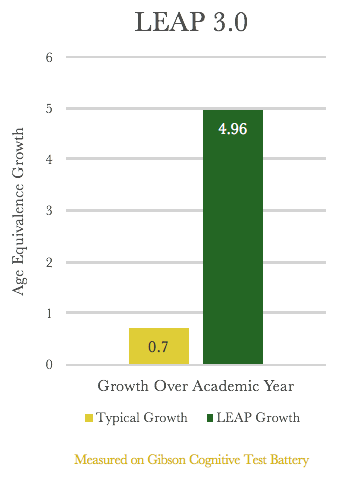Developed and tested over 43,000 hours in our own learning laboratories, our Learning Efficiency Acceleration ProgramTM (LEAP) 3.0 is a set of interventions that transformatively addresses learning challenges caused by ADHD, Dyslexia, Working Memory challenges, Executive Functioning deficits and Anxiety. At its core, LEAP increases learning outcomes by helping students more efficiently take in information, cognitively process received information, and manipulate that information within the context of school or beyond.
Unlike any other program currently available, LEAP is unique because of the way in which the program is customized for each student’s specific needs. While our Education Team systematically invests time to incorporate groundbreaking research regarding how all students and their brains learn best, we start all LEAP programs with an in-house assessment to better hand select targeted exercises from over 250 hours of curriculum. LEAP 3.0 focuses on enhancing the brain’s organizational efficiency through tiered exercises that increase in difficulty and gets results by leveraging a student’s strengths while supporting their specific deficits. As such, while LEAP benefits lots of students, each student’s LEAP program might look different in focus, length, and intensity.

When a student’s underlying challenges are addressed, this leads to increased performance in academic settings. On average, students who participate in LEAP 3.0 for a minimum of 50 hours see:
Overall, parents reported noticing that their student was:
On average, students who participate in LEAP 3.0 for a minimum of 50 hours (out of 250 hours of available exercises) improved by an average of over 4.9 years in cognitive growth!
| Cognitive Processing Skill | Implications of Skill | Average Improvement |
|---|---|---|
| Working Memory | The ability to store, retain, and retrieve information – Listening to the teacher give directions and knowing how to respond. | 6.1 years |
| Visual Processing | The ability to picture, manipulate, organize, comprehend, and think with visual information – Looking at a puzzle or map and being able to understand it. | 3.5 years |
| Processing Speed | The ability to perform relatively easy mental tasks quickly – Completing mental math for a discount on milk at the store. | 3.2 years |
| Decoding | The ability to know and apply sound codes to pronounce unknown words – Being able to read new words in a chapter book. | 3.4 years |
| Auditory Processing | The ability to blend, segment, discriminate, and analyze speech sound within a spoken pattern – Listening to the teacher talk and not missing or misunderstanding any of the directions. | 9 years |
| Logic and Reasoning | The ability to reason and solve spatially defined problems – Solving sequenced math problems. | 4.5 years |
| Selective Attention | The ability to prioritize information and tasks with other competing stimuli – Focusing on homework while others are talking or construction is outside. | 2.4 years |
| Overall | --- | 4.9 years |